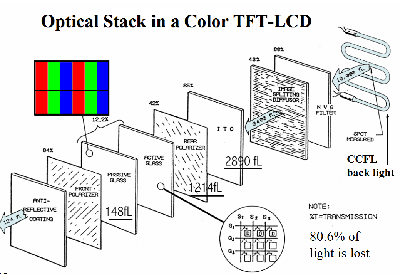LCD – For the Novice and the Expert
by Kristopher Kubicki on September 4, 2003 12:13 AM EST- Posted in
- Displays
Substrates and you
Undoubtedly, the glamour behind LCDs lies in the substrate production. Producing LCDs are very different from any other component. Cramming 4 million transistors on a 17" piece of glass does not seem too difficult of a task, when we consider that modern CPUs have 60 million transistors on a square inch. Unfortunately, CPU manufacturers are able to get away with lower yields since processors will lower quality are simply marked as lower speed and shipped. LCDs do not have that luxury, since a 1% defect rate would result in 40,000 dead sub pixels. It’s very easy to see why some substrate manufacturers pride themselves with 60% yields.Without getting overly technical, the substrate manufacturing process relies on three basic ingredients. The first is a layer of TFTs, or glass substrates with transistors attached to it. These create the electronic array that controls the liquid crystals. The second layer is a thin (as in micrometers) film of liquid crystals. Another special glass substrate, called a color filter, is fitted over the liquid crystal. The backlight is attached to the rear of the TFT substrate, and the LCD is born.
©Samsung. Click to enlarge.











63 Comments
View All Comments
Anonymous User - Thursday, September 4, 2003 - link
Aaaahhhhh! Dr. Strangelove I presume.dvinnen - Thursday, September 4, 2003 - link
what's up with all the posts...it's really freakin me out...
I'm used to the twice a month ones...
Well, the bright side is this is suppose to be a boring strtch to Athlon 64 and Prescott release, wonder how many we'll get then.
Anonymous User - Thursday, September 4, 2003 - link
Yup. I gave up on waiting for a quality LCD for gaming. Bought a NEC FP912 to last me the next couple of years.Maybe LCDs + gaming will be an uncompromised reality then.